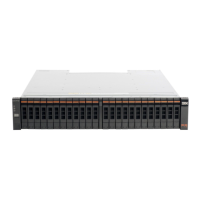
Do you have a question about the IBM Storwize V7000 Unified Series and is the answer not in the manual?
| Form Factor | 2U |
|---|---|
| Maximum Drives | 504 |
| RAID Levels | 0, 1, 5, 6, 10 |
| File Protocols | NFS, CIFS/SMB, FTP, HTTP, HTTPS |
| Drive Types | SAS, SSD |
| Maximum Cache | 64 GB |
| Host Interface | 8 Gb FC, 16 Gb FC, 10 Gb iSCSI, 1 Gb iSCSI |
| File System Support | GPFS |
| Data Services | Thin provisioning, Easy Tier, FlashCopy, Remote Mirroring |
| Management Interface | CLI |
| Scalability | Scale-out |
| Operating System Support | Windows, Linux, AIX, VMware |
| Power Supply | Redundant power supplies |
| Maximum Capacity | Up to 4PB |
Crucial safety information to review before installing the product.
Identifies system administrators as the primary audience for this guide.
Explains the use of different typefaces for emphasis in the document.
Explains the process for ordering IBM publications.
Emphasizes recording critical system access details for troubleshooting ease.
Outlines proper procedures for powering down system components to prevent data loss.
Guides on configuring the system for proactive event notifications.
Stresses the importance of regularly backing up configuration and volume data.
Provides guidance for troubleshooting installation-related problems.
Helps resolve issues encountered during the initial system configuration.
Addresses common failures in the Easy Setup Wizard, particularly DNS-related issues.
Details procedures for checking network port status for GUI connectivity.
Explains how to review system health indicators and resolve related issues.
Guides on troubleshooting Ethernet network connectivity between hosts and file modules.
Details the process for changing the control enclosure's system IP address.
Explains how to update file module records with the control enclosure's IP.
Guides on using file node LEDs to identify error sources.
Explains the appropriate scenarios for using the management GUI for system servicing.
Guides on utilizing fix procedures to diagnose and resolve system problems.
Details common maintenance and repair tasks for file modules.
Provides instructions for initiating a file module reboot.
Outlines the process for removing a file module for maintenance.
Guides on troubleshooting when multiple hard disk drives fail.
Helps diagnose issues when multiple hard drives appear offline.
Explains the structure and meaning of Storwize V7000 Unified error codes.
Details the components that make up an error code.
Explains how to identify the originating device of an error.
Explains the meaning of different error severity levels.
Illustrates how to interpret alphanumeric error codes for Ethernet issues.
Lists customer and field replaceable units (CRUs/FRUs) and their replacement procedures.
Lists the interfaces available for troubleshooting and maintaining the system.
Describes the browser-based GUI for servicing node canisters.
Explains when the service assistant is primarily used.
Explains when to use the storage system CLI for advanced users.
Provides steps for initializing and using a CLI session.
Explains when to use the service CLI for advanced users.
Lists situations where using a USB key is required.
Explains how to use a USB key formatted with specific file systems.
Lists methods used to notify about new events.
Classifies events as alerts or messages.
Guides on viewing the event log via GUI or CLI.
Explains how event log entries are coalesced.
Describes fields in the event log used for diagnosing problems.
Lists informational and error event types.
Explains how error codes help identify problem causes.
Guides on using the management GUI's recommended actions for diagnosis.
Lists the interfaces available for troubleshooting and maintaining the system.
Describes the browser-based GUI for servicing node canisters.
Explains when the service assistant is primarily used.
Advises awareness of all safety issues before part replacement.
Describes how to replace a node canister.
Guides on configuring the remote support system using Tivoli Assist On Site software.
Details how to establish an AOS connection for remote support.
Covers recovery procedures related to user ID and system access.
Guides on logging onto a file module as root.
Provides steps to recover a lost root password.
Guides on resetting System x firmware to default settings.
Guides on recovering file systems after volumes return online.
Guides on fixing offline file volumes.
Addresses recovery actions indicated by a 1001 error code.
Advises on when to attempt a system recovery procedure.
Explains the process of backing up system configuration.
Explains the process of restoring system configuration.
Guides on deleting old backup configuration files.
Lists major accessibility features available in the management GUI.
Explains keyboard navigation methods for the management GUI.
Explains the FCC statement regarding device emissions.